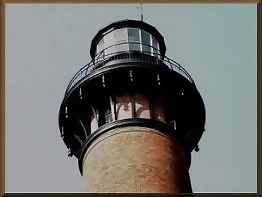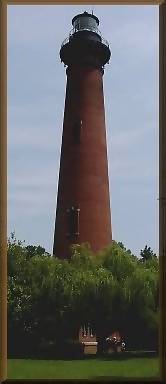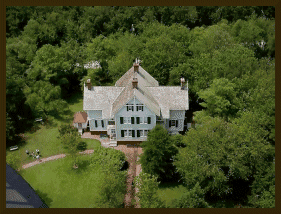

The Currituck Beach Light Station
The Currituck Light Station is located in an area of dense foliage. It is a long way to the top. You can see the railing where climbers can hold on to once they reach the top of the Light Station. At the top, the view is gorgeous. To see the sound, a strip of land, and the sea altogether at once, at least for me, is fascinating.
Please click here to read the latest update about the Currituck Light Station. Your help is needed.

"On December 1, 1875 the beacon of the Currituck Beach Lighthouse filled the remaining "dark spot" on the North Carolina coast between Cape Henry Light to the north and Bodie Island to the south. To distinguish the Currituck Beach Lighthouse from other regional lighthouses, its exterior remains unpainted and gives today's visitor a sense of the multitude of bricks used to form the structure. The lighthouse was automated in 1939 when the United States Coast Guard assumed the duties of the Bureau of Lighthouses. At a height of 158 feet, the night beacon still flashes at 20-second intervals to warn ships hugging the chain of barrier islands along the coast.
The Lighthouse Keepers' House, a Victorian "stick style" dwelling, was constructed from pre-cut and labeled materials which were shipped by the U.S. Lighthouse Board on a barge and then assembled on site. In 1876, when the Keepers' House was completed, two keepers and their families shared the duplex in the isolated seaside setting. The keepers were removed after the Lighthouse was automated and attendants were no longer needed to clean the lenses, trim the wicks, fuel the lamp, and wind the clockwork mechanism which rotated the beacon.
As it had reported in previous years, the U.S. Light-House Board in 1872 stated that ships, cargoes and lives continued to be lost along the 40 miles of dark coastline that lay beyond the reaches of existing lighthouses. Southbound ships sailing closer to shore to avoid the Gulf Stream were especially in danger. In response, construction began on the Currituck Beach Lighthouse in 1873 with completion two years later.

The Currituck Beach Lighthouse is known as a first order lighthouse, which means it has the largest of seven Fresnel lens sizes. The original source of light was a U.S. mineral oil lamp consisting of five concentric wicks: the largest was 4 inches in diameter. Before the advent of electricity, a mechanical means was required to rotate the huge lenses that made the light appear to flash. A system of weights suspended from a line powered a clockwork mechanism beneath the lantern - much like the workings of a grandfather clock. The keeper cranked the weights up by hand every two and a half hours.
Like the other lighthouses on North Carolina's Outer Banks, this one still serves as an aid to navigation . The beacon comes on automatically every evening at dusk and ceases at dawn. With a 20-second flash cycle (on for 3 seconds, off for 17 seconds), the light can be seen for 18 nautical miles. The distinctive sequence enables the light house not only to warn mariners but also to help identify their locations. The Currituck Beach Lighthouse was the last major brick lighthouse built on the Outer Banks."
With a 20-second fash cycle (on for 3 seconds, off for 17 seconds), the light can be seen for 18 nautical miles. The distinctive sequence enables the lighthouse not only to warn mariners but to help identify their locations.
The Currituck Beach Lighthouse was the last major brick lighthouse built on the Outer Banks.

By the late 1970's the Lighthouse Keepers' House stood open to the elements with no windows or doors; porches had decayed and vines invaded the north side. Much of the interior millwork had been vandalized. Concerned about the preservation of the historic property, Outer Banks Conservationists, Inc., a private non-profit organization dedicated to the conservation of the character of the Outer Banks of North Carolina, signed a lease with the State of North Carolina in 1980 to begin a phased restoration of the property. The lease charged the group with the responsibility of restoring the Keepers' House and improving the historic compound.
Today, the grounds and walkways are rejuvenated and the exterior of the Keepers' House is nearly complete, but the phased restoration of the interior remains a considerable undertaking. Although plaster walls and pine floors have been repaired, vandalized wainscoting replaced, and the mahogany balustrades replicated, reproduction doors and hardware must be made and installed, and the interior finishes applied.
Credits:
OUTER BANKS CONSERVATIONISTS, INC.
Currituck Beach Lighthouse
P.O. Box 58, Corolla, NC 27927
Permission Granted in writing September 4, 2000
Ms. Lloyd D. Childers, Executive Director/Light Keeper
The Currituck Beach Light Station Gallery, Part 1
The Currituck Beach Light Station Gallery, Part 2


Site Map!
Copyright © 2001-2008 Janice I Magro
All Rights Reserved.